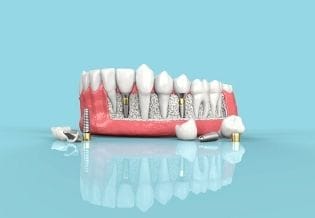Aims & Scope
Core Research Domains
Oral Implantology & Surgery
Clinical and translational research in dental implant systems, osseointegration, and surgical protocols.
- Implant design and surface modifications
- Osseointegration mechanisms and bone biology
- Immediate loading protocols
- Peri-implantitis prevention and management
- Computer-guided implant surgery
- Bone augmentation techniques
Prosthodontics & Restorative Dentistry
Advanced materials, techniques, and clinical outcomes in fixed and removable prosthodontics.
- CAD/CAM restorations and digital workflows
- Ceramic and composite material science
- Implant-supported prostheses
- Adhesive dentistry and bonding protocols
- Full-arch rehabilitation strategies
- Occlusal rehabilitation and TMJ considerations
Periodontics & Soft Tissue Management
Periodontal disease mechanisms, regenerative procedures, and peri-implant tissue health.
- Periodontal regeneration and tissue engineering
- Minimally invasive surgical techniques
- Soft tissue grafting and augmentation
- Peri-implant disease diagnosis and treatment
- Laser-assisted periodontal therapy
- Microbiome analysis in periodontal health
Dental Biomaterials & Technology
Material science innovations, biocompatibility testing, and emerging technologies in dentistry.
- Bioactive materials and remineralization agents
- 3D printing applications in dentistry
- Nanotechnology in dental materials
- Biocompatibility and cytotoxicity assessment
- Smart materials and drug delivery systems
- Artificial intelligence in treatment planning
Secondary Focus Areas
Interdisciplinary Approaches
- Orthodontic-implant interactions and anchorage
- Endodontic-periodontic lesions and management
- Oral medicine and mucosal disease diagnosis
- Geriatric dentistry and age-related considerations
- Pediatric oral rehabilitation with implants
Advanced Imaging & Diagnostics
- Cone beam computed tomography (CBCT) applications
- Intraoral scanning and digital impressions
- Optical coherence tomography in dentistry
- AI-assisted radiographic interpretation
- Virtual surgical planning and simulation
Clinical Outcomes Research
- Patient-reported outcome measures (PROMs)
- Quality of life assessments post-treatment
- Long-term implant survival and success rates
- Cost-effectiveness analyses of treatment modalities
- Complication management and risk factors
Aesthetic & Digital Dentistry
- Smile design and digital aesthetic planning
- Color science and shade matching protocols
- Minimally invasive aesthetic procedures
- Digital workflow integration in practice
- Virtual patient communication tools
Emerging Research Frontiers
Regenerative Medicine
- Stem cell applications in dental regeneration
- Growth factor delivery systems
- Tissue engineering scaffolds for bone and soft tissue
- Gene therapy approaches in periodontology
Robotic & AI-Assisted Dentistry
- Robotic surgical systems for implant placement
- Machine learning for treatment outcome prediction
- Automated diagnosis and treatment planning
- Augmented reality in dental education and surgery
Out of Scope
- General Medical Conditions: Systemic diseases without direct oral manifestations or dental treatment implications (e.g., cardiovascular disease management, diabetes control without oral complications).
- Veterinary Dentistry: Animal dental care, veterinary oral surgery, or comparative anatomy studies without human clinical application.
- Agricultural Sciences: Plant genetics, crop science, soil chemistry, agricultural technology, or any non-dental biological sciences.
- Basic Sciences Without Dental Context: Pure biochemistry, anatomy, or physiology studies lacking clear connection to dental practice or oral health outcomes.
- Non-Evidence-Based Approaches: Anecdotal reports, uncontrolled case series without statistical analysis, or treatments lacking scientific validation.
Article Types & Editorial Priorities
Expedited Editorial Processing
Regular Editorial Timeline
Limited Acceptance
Editorial Standards & Requirements
Reporting Guidelines
All submissions must adhere to established reporting standards: CONSORT for randomized trials, STROBE for observational studies, PRISMA for systematic reviews, CARE for case reports, and ARRIVE for animal studies. Non-compliance results in desk rejection.
Research Ethics
Human studies require IRB/ethics committee approval with documented informed consent. Animal research must follow institutional guidelines and demonstrate ethical justification. Clinical trial registration (ClinicalTrials.gov or equivalent) is mandatory for interventional studies.
Data Transparency
Authors must provide access to underlying data supporting results through public repositories or supplementary materials. Statistical analysis code, imaging protocols, and material specifications should be available upon reasonable request.
Preprint Policy
Preprint posting on recognized servers (bioRxiv, medRxiv, arXiv) is permitted and encouraged. Authors must disclose preprint DOI at submission. Preprint availability does not affect consideration for publication.
Conflict of Interest
All financial relationships, industry affiliations, and potential conflicts must be disclosed. Industry-sponsored research is accepted if study design, data analysis, and manuscript preparation maintain academic independence.
Image Integrity
Clinical photographs, radiographs, and microscopy images must be unmanipulated except for brightness/contrast adjustments applied uniformly. Any image processing must be disclosed in methods. Suspected manipulation triggers investigation.


